A Bit of Background:
It’s been a rather uneventful year at the movies so far. It’s not that there haven’t been movies worth getting excited over…it’s just that with the exception of ‘Star Trek’, the excitement I personally felt for some recent films- ‘Public enemies’, ‘The Brothers Bloom’, ‘Still Walking’, ‘Anvil!’, Coraline’ and a few others- seemed to dissipate, either because of how long it took the films to get to Israel, or it simply was not shared by others. ‘Star Trek’ was over four months ago, and there was no phenomenon like ‘Wall-E’ or ‘The Dark Knight’ for me to personally connect with a film-going audience worldwide.
Interrupting the doldrums is Tarantino.
In recent years, I’d become increasingly ambivalent about Tarantino. I still returned to his first three films with pleasure, and grew to love ‘Kill Bill vol. 2’. But it seemed like the time had passed for Tarantino’s self-contained cinematic world. Also, as his influence on pop filmmaking became the norm, in many ways, I found that the general response of young audiences to the kind of pulp fiction that was being made, to be alarmingly disproportionate to their actual standing in the universe. ‘Fight Club’, ‘Requiem for a dream’, ‘Oldboy’, ‘The Boondock Saints’, ‘Lucky Number Slevin’, the early Guy Ritchie films…these may not have been the only films that film-goers in their teens and early 20’s were seeing, but they struck me as being the most popular group of films.
My problem is not that these films –dealing in drugs, revenge, robbery, nihilism and other fun stuff- are not good. The problem lies in how they dominate the interests of young film-goers. I am of the opinion that those films have a respectable place in the culture, but that that place is not front-and-center. It is essential they have a context. Lacking that, we get a generation that can readily quote and relish Samuel L. Jackson’s bad-ass recitation of a paraphrased Ezekiel, but fail to remember the strong morality Jackson applies to the words at the end. They remember The First Rule of Fight Club and the cathartic quality of seeing someone getting beaten to a pulp, but not the dénouement. The twist ending, but not the fact that the ending acknowledges the falseness of the seductive façade. And if they could face reading the subtitles, they are struck by the inventive and entertaining bloodletting of ‘Oldboy’, without the moral reckoning. This ‘Cinema of Cool’ may lie only in the partial-reading of the films, caused by a lack of context, but it has nevertheless given me pause when considering Tarantino’s place in cinematic culture.
…but I digress. To quote a recent favorite- ‘Watcha got ain’t nothing new…That’s vanity’. These qualms of mine are strong because I’ve personally experienced both sides of the spectrum, Tarantino-wise. I’m sure these issues have been raised by many a cinephile over the decades, in one form or another (each decade and its problems). It is unfair to saddle Tarantino with the guilt because of association.
It was easy to point a finger with ‘Death Proof’, an exercise in genre that I found to be stricken with ennui. For its handful of compelling features, it felt like an utterly weight-less feature, one which Tarantino could have directed in his sleep. ‘Kill Bill vol. 2’ worked despite my ignorance of the genre it was working off of; it had a deep reserve of emotion in it. ‘Death Proof’ felt like a tossed-off love letter to a genre I didn’t particularly know, and the film seemed quite unconcerned with those uninitiated to the genre. A rare lack of generosity for Tarantino, who in general has a tremendous amount of giddy enthusiasm to share with his audience.
I’ve been looking forward to ‘Inglourious Basterds’ ever since I first heard about it a few years back. Tarantino making a WWII men-on-a-mission film about tough Jews killing Nazis….sounded too good to be true. When he announced last year that it was actually going to happen, however, it sounded a bit more problematic. It was a rushed production, the cast didn’t sound as awesome as it could have, the trailer was disappointing…I was unsure about it. Not any more. I am now sure that it is a great film. The most fascinating film I’ve seen all year. There is so much in it worth discussing, and it doesn’t fit into any kind of normal construct. What I will attempt to do is break it down into palatable pieces.
‘Basterds’ has five chapters, the first two set in 1941, the last three in 1944. The first four chapters each focus on a different set of characters, with overlap. The fifth brings everything and everyone together (everyone who managed to survive, that is).
Character
The film is populated by a mix of different characters, from a mix of different genres. It doesn’t have a single main character, but a triumvirate, not entirely dissimilar ‘The Good, The Bad and The Ugly’, which is by no coincidence Tarantino’s favorite film of all time.
The first of the three that we meet, in Chapter 1, (subtitled ‘Once Upon a Time…in Nazi occupied France’) is The Bad- SS Colonel Hans Landa –aka The Jew Hunter- played by German actor Christoph Waltz. Landa is a spectacularly seductive villain, in the troubling tradition of Lecter, Chigurh and the Joker. He is a Nazi temperamentally, not morally. It would be easiest to peg him as amoral, but there is a conviction to him that gives an air of a kind of esthetic code, which substitutes morality for him. His pleasure is not in killing Jews (not that he minds it), but in hunting them. Landa fancies himself a detective and a Renaissance man, speaking at least four different languages. Existence is a big game, and he is convinced that he is the best player there is. Indeed, one gets the sense that he is a Nazi simply because it presents the most opportunities for intellectual stimulation. When the situation presents itself, he can become a cold Capitalist, with that nouveau-riche dream of a house in Nantucket. Waltz deservedly won the best actor award at Cannes, for doing justice to Tarantino’s dialogue, and bringing to life one of the most memorable characters to be seen in recent years.
The second main character is Brad Pitt’s Lt. Aldo Raine; leader of the Basterds, who is introduced in Chapter 2 (subtitled simply ‘Inglourious Basterds’). A caricature of a caricature, Raine is a part-Apache mayhem maker. Just about oblivious to nuance and skeptical of subtlety, Raine is the latest in a long line of Pitt character turns. As a movie star, Pitt is generally somber and subdued. As a character actor –’Thelma & Louise’, ‘True Romance’, ‘Snatch’, ‘Fight Club’, ‘Burn After Reading’- he comes off as loose and limber, one of the most inventive actors around. Raine is not really The Ugly of this story, more like The Other Good. But like Eli Wallach in that film, he is a wonderful, very entertaining sideshow in the rather more serious fight between The Good and the forces of evil. He has a part to play in the ultimate showdown, but he’s second fiddle to The Good- Shoshanna Dreyfus, played by Mélanie Laurent.
Shoshanna is the hardest of the characters in the film to get a grip on, because she is the closest thing to a real character Tarantino has in the film. Not prone to the intricate dialogue of Landa or the rough and hilarious colloquialisms of Raine, Shoshanna is a quiet, introverted character, and the heart of the film. She first appears in Chapter 1, the lone survivor of Landa’s discovery of a group of Jews being hidden by a French farmer. When we find her in Chapter 3 (subtitled ‘A German Night in Paris’), three years have passed since that horrific encounter. She is living under an assumed identity, as the owner of a Parisian movie-theater. She puts on a front of an average young bourgeois woman, only being honest with the black projectionist, safe inside her theater. It is her righteous revenge tale that fuels the film, not the Basterds’. Though, by the end, both come together into on big fantasy that is both cathartic and sad- cathartic in it’s wish fulfillment, sad in how utterly untrue it is (more on that later).
The Sum of its Parts
One way of looking at the first sequence of this film:
It is 1941, in Nazi occupied France, and Perrier LaPadite, a French farmer, is cutting wood for his three daughters. A car approaches. Out of the car comes SS Colonel Hans Landa, who asks LaPadite to step into his home for a chat. Landa asks for a glass of milk, and the whereabouts of a Jewish family that is in hiding. They enter into a conversation, which resolves in a revelation. The farmer is a good man, the SS officer is not.
Here’s another way to look at the sequence:
It begins with the melody ‘The Green Leaves of Summer’, from the film ‘The Alamo’, directed by and starring John Wayne. Dimitri Tiomkin wrote that score, the year before he scored ‘The Guns of Navarone’. The title card tells us that this is Chapter 1, subtitled ‘Once Upon a Time…in Nazi occupied France’, a reference to Sergio Leone. The landscape is soon revealed to be inspired by Leone. Music by Leone’s composer Ennio Morricone (re-appropriating Beethoven) makes for a matching soundscape, which co-exists with an image that brings to mind ‘Saving Private Ryan’. An interrogation commences in which both sides are role-playing, complete with props out of Sherlock Holmes that also imply one-upmanship. There is Hitchcock’s proverbial bomb under the table, but instead of a bomb, it is an image out of history’s darkest chapters. There is a horrific outburst of violence that is evil, tragic, and extremely sad. Before it can fully sink in, however, we get a reference to John Ford’s ‘The Searchers’, a seemingly doomed escape, and the beginnings of a revenge tale.
The sequence is epic and intimate, specific and all-encompassing, funny and terrifying. A terrific story. At the same time, it is a succession of moment of all shapes and sizes. A look, a sound, a piece of music, a line of dialogue, a bit of lighting, a tiny gesture. Some are movie reference, some are genre staples (war, suspense, holocaust, detective, western…among others), some are both, many are neither. Nary a second goes by without some small thrilling moment that is unique to film. The sequence is a brilliant concoction of moments. Story and moments. Content and style. The entire film is not as perfect as this sequence, and it does get a bit ungainly at times. But it’s got a damn good yarn to tell, and more sublime moments of film than any five new films I’ve seen recently.
The genre mixes are initially jarring; they feel a bit like stream of consciousness shifts in tone. But the film’s exuberance smoothes over some of the more jarring moments, like the Loony Tunes-ish Hitler, a cool vocal cameo that appears only twice, when it was needed either more or less often. Same goes for writing appearing on the screen- it is used too little to really make tonal sense. And I may be alone on this, but I did not feel like the use of David Bowie’s ‘Cat People’ for a critical moment in the film worked. The aural universe of the film was set in a certain time and place (namely, the 60’s), the Giorgio Moroder-penned theme took away from the gravitas of the final chapter (luckily, Morricone gets the last word). But more often, the moment-by-thrilling-moment-ness of it all makes bits of absurdity that one gets but can’t explain sublimely perfect, inexplicable though they still are. In fact, those are some of the best moments in the film, because they serve no master other than the audience, and exist for our enjoyment.
Most audiences might not be aware of these moments, and won’t get a lot of the references (I am reasonably film-literate, and missed more than I care to admit). But unlike ‘Kill Bill vol. 1’ or ‘Death Proof’, I don’t feel like the references are critical for enjoyment, and you certainly don’t need to be aware of the tiny moments for them to work on you. The film is long, has a lot of people sitting and talking, and a great deal, if not most of it, is subtitled into German or French (or, in one of the most entertaining scenes, Italian). Yet it is Tarantino’s most successful film to date. Among other things, he’s proven that audiences can be far more patient and open-minded than is assumed, if only given the chance.
Charades
That patience is either most tested or most rewarded in Chapter 4, subtitled ‘Operation Kino’. Lt. Archie Hicox (Michael Fassbender), film critic and aficionado of German cinema, member of the British OSS, is debriefed (by Mike Myers in a strange cameo that only kind of works) about a plan to do the Reich some damage. He links up with the Basterds in France, and goes for a rendezvous in a tavern cellar with an undercover British agent. This scene is probably the most divisive in the film. It is the longest single scene, for one. It barely features one of our main characters (Aldo is in a bit in the beginning and the end) and seemingly is not heavy on moving the plot forward. It goes on for a while before the crux of it is revealed, after which it becomes a suspense scene that goes on for a very long time. There’s an antagonist in it, but he seems a lightweight compared to Landa. It feels like a tangent, a short film exploring one of the dozens of storylines that are peripheral to the main story. It feels like spin-off. Yet, miraculously enough, it succeeds in being a highlight of the film, and an exploration of a sub-theme in the film: performance.
Hicox goes to the tavern in an SS uniform, accompanied by Sgt. Hugo Stiglitz (Til Schweiger) and Cpl. Wilhelm Wicki (Gedeon Burkhard) two of the Basterds. Wicki is a Jewish German refugee who became a GI. Stiglitz is a German soldier who, of his own accord, went about killing Gestapo officers, before being drafted into the Basterds. All three men speak German, with different accents. They are pretending to be SS officers. Their contact is a German actress (Diane Kruger) who is really a British agent. When joined by a real Gestapo officer, they need to improvise a background story to explain Hicox’ accent, and play a game of trying to figure out what character was assigned to them by the person sitting next to them. This Gestapo agent is playing dumb. The scene is a nail-biting suspense scene in which acts are dropped and masks unveiled.
Landa is the most varied of the performers in the film- In chapter 1, he acts informal and oblivious, until he reveals his true intentions. In chapter 3, we cannot be sure how much is an act, and what his intentions are. In the final chapter, we know he is working hard at acting innocuous, but not why- it seems plainly unnecessary. He is contrasted by Aldo, who can exaggerate, but is a hopeless actor. His only character is Aldo, part Apache Nazi-hater. He stages grand performances for his captives, orchestrates grand entrances, but they are grand and purposeful, not deceptive in nature. He is the only match for Landa precisely because he’s a terrible actor- Landa’s rules don’t apply to him. He doesn’t out act him; he ends the charade (in a particularly patriotic context). Then there is Shoshanna, who puts on the plainest and most painful charade: A Jew, pretending to be a gentile. But she gets to remove a mask in the finale, in an act of affirmation, of justice that transcends mortality.
Fantasy
Shoshanna’s actions, and the Basterds’, have caused the film to come under attack for its supposed bastardization of history. Daniel Mendelssohn, in a widely circulated Newsweek article (http://www.newsweek.com/id/212016) criticized the film for the cruelty of the Basterds, saying that Tarantino did a great wrong to history by turning Jews into Nazis.
The acts of violence that Jews inflict on Nazis in the film can be divided into acts of terror and acts of revenge. Each carries an element of both, but until the final act, there is a pretty clear separation. The initial mission of the Basterds is to wreak havoc among the Nazi occupiers in France. The Basterds are swift and merciless, and have taken the methods of Aldo’s Apache ancestors for themselves, namely scalping their victims. This act, grisly though it may be, has a very practical purpose. First and foremost, it achieves their goals of spreading the fear of a savage avenger. Secondly, in conjunction with Donny Donowitz aka The Bear Jew (Eli Roth, not particularly mythic) beating a Nazi officer to death with a baseball bat, it is very effective at getting prisoners to reveal their unit’s position. In the aforementioned grand performance Aldo orchestrates, the pomp and circumstance and Grand Guignol Theater saves the Basterds from an enemy ambush, and spreads fear of Aldo the Apache and the dreaded Bear Jew. Tarantino pushes the idea of terrorism further by accompanying one of the Basterds exploits with Morricone’s theme from ‘The Battle of Algiers’, one of the most powerful films ever made about terrorism, where those methods are used to righteous end. He pushes it ever further with the specter of Jewish suicide bombers. With these associations, I did not get the sense that Tarantino is applying a great deal of morality or politics…just a good way of getting back at someone.
On the other hand, there are a few very disturbing images late in the film that do rather obviously impart a victim status on some of the Nazis being killed, images that bring to mind gas-chambers and ovens. Tarantino has balked at the idea of a hidden agenda here (‘was I too cruel to Nazis?!’), and I do believe that generally, the morality that generally interests him is a cinematic good vs. evil, not much in between. But with these images, in addition to the concept of repaying a villain in kind, Tarantino also adds a measure of discomfort, saying that revenge cannot be righteous if it doesn’t come at some sort of cost. That is why he gives us another sight of violence after this, which combines revenge, terror and a rebuke to forgetting. He’s been accused of a form of Holocaust denying, by re-molding history to his liking. But to say that would be to miss the point of the final images of the film. It is a fantasy and has no illusions of being otherwise. Yes, Tarantino does literally use the power of film to get his revenge of the Nazis. But that metaphor does not enforce the film’s power over history; it is an acknowledgement that only in film can the Nazis get what they deserve.
It is pure fantasy that he allows us to indulge in. With the penultimate image, he is giving a big, loud and effective “NEVER FORGET”. With the final one, well, he is requesting our thanks of his efforts. It’s a cocky and impertinent request, but the powerful, invigorating, and peerless film he’s given us deserves nothing less. I agree with Tarantino- This might just be his masterpiece.

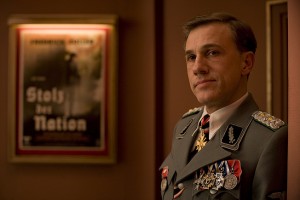
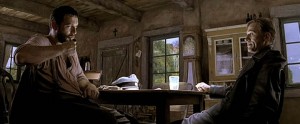
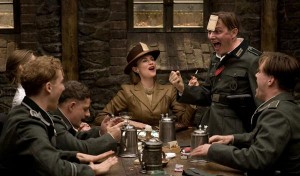
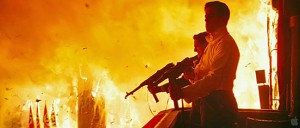
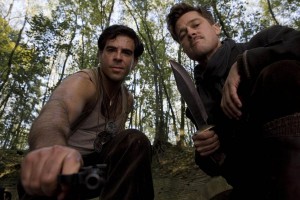




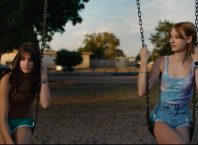
Comments are closed.